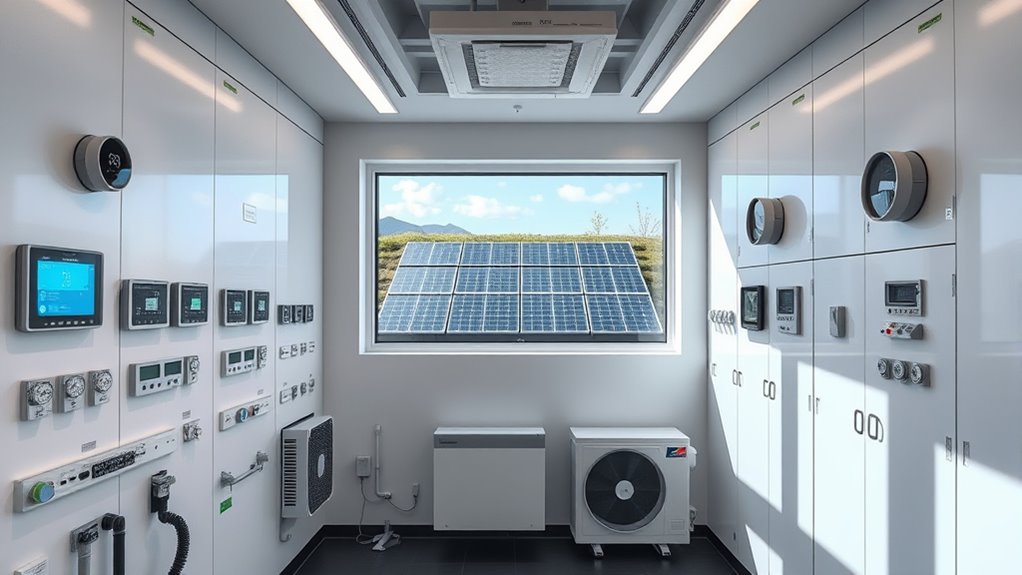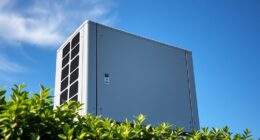HVAC systems are essential for achieving net-zero buildings because they optimize energy use through advanced controls, smart thermostats, and high-efficiency components. By integrating renewable energy sources like solar or geothermal, and employing passive design strategies, you can markedly reduce energy consumption. Continuous monitoring helps fine-tune performance, ensuring comfort while minimizing environmental impact. If you want to discover how these strategies work together for sustainable results, keep exploring the key approaches to net-zero building design.
Key Takeaways
- HVAC systems can incorporate advanced controls and high-efficiency components to reduce energy consumption while maintaining occupant comfort.
- Integrating renewable energy sources like solar-powered heat pumps decreases reliance on grid power and cuts emissions.
- Passive design strategies, such as insulation and heat recovery, lower heating and cooling loads, easing HVAC energy demands.
- Continuous monitoring and optimization of HVAC performance ensure systems operate efficiently toward net-zero energy goals.
- A holistic approach combines HVAC upgrades, passive measures, and renewable energy to achieve sustainable, net-zero buildings.

Achieving net-zero buildings requires integrating highly efficient HVAC systems that minimize energy consumption while maintaining comfort. Your goal is to reduce reliance on traditional energy sources, and that starts with smart, energy-efficient upgrades. Upgrading your HVAC system to one with advanced controls, better insulation, and high-efficiency components can substantially cut energy use. These improvements not only lower your building’s operational costs but also help you meet sustainability targets. When considering energy-efficient upgrades, focus on systems that maximize performance based on real-time conditions. Variable speed fans, smart thermostats, and zoning controls allow your HVAC system to operate only when necessary, reducing waste and enhancing comfort.
Integrate advanced controls and high-efficiency components for smarter, energy-saving HVAC performance.
Renewable energy integration plays a crucial role here. Incorporating solar panels, wind turbines, or geothermal systems can supply your HVAC with clean, renewable power. This way, you’re not just reducing energy consumption but also sourcing power sustainably. For example, solar-powered heat pumps can provide heating and cooling by harnessing sunlight, further decreasing your carbon footprint. When integrating renewable energy, it’s essential to size your systems appropriately and ensure they work seamlessly with your HVAC setup. Smart energy management systems can coordinate your renewable sources with your HVAC operation, maximizing efficiency and ensuring your building consumes as little grid power as possible.
Your HVAC design should prioritize passive strategies alongside active systems. Effective insulation, airtight construction, and strategic shading minimize the heating and cooling load, reducing the strain on your HVAC system. This means your system doesn’t have to work as hard, leading to lower energy consumption. Additionally, employing heat recovery ventilators can reclaim thermal energy from exhausted air to precondition incoming fresh air, further boosting efficiency. These measures, combined with energy-efficient upgrades and renewable energy integration, create a synergistic effect that pushes your building closer to net-zero.
Monitoring and adjusting your HVAC operation are equally important. Continuous data collection helps identify inefficiencies or areas for improvement. Advanced sensors and building management systems enable you to fine-tune system performance, ensuring ideal energy use without sacrificing comfort. Over time, these insights allow you to make informed decisions about future upgrades or adjustments, keeping your building aligned with net-zero goals.
In essence, achieving net-zero buildings through HVAC involves a holistic approach—upgrading to energy-efficient systems, integrating renewable energy sources, optimizing passive design features, and maintaining vigilant performance oversight. By doing so, you create a sustainable, comfortable environment that minimizes environmental impact and supports your long-term energy goals.
Frequently Asked Questions
How Do HVAC Systems Impact Indoor Air Quality in Net-Zero Buildings?
Your HVAC systems directly impact indoor air quality by using air filtration and implementing effective ventilation strategies. Proper filtration removes pollutants and allergens, ensuring cleaner air, while well-designed ventilation exchanges stale air for fresh, conditioned air. In net-zero buildings, these systems optimize energy use without compromising air quality, creating a healthier indoor environment. You can enhance air quality by regularly maintaining filters and adjusting ventilation to meet occupancy needs.
What Are the Latest Innovations in HVAC Technology for Energy Efficiency?
You should explore smart thermostats and variable refrigerant flow (VRF) systems, as they’re leading innovations in HVAC for energy efficiency. Smart thermostats learn your schedule, optimize heating and cooling, and reduce waste. VRF systems adjust refrigerant flow to different zones, delivering precise temperature control while consuming less energy. Together, these technologies help you lower energy bills and contribute to achieving net-zero buildings by maximizing efficiency and comfort.
How Do Renewable Energy Sources Integrate With HVAC Systems?
Imagine transforming your HVAC system into a powerhouse of sustainability. You can achieve this by integrating renewable energy sources like solar and geothermal. Solar integration harnesses sunlight to generate electricity, powering your system efficiently, while geothermal coupling taps into the earth’s stable temperature for heating and cooling. Together, these technologies reduce reliance on fossil fuels, making your building more energy-efficient and pushing you closer to net-zero goals.
What Are the Cost Implications of Implementing Advanced HVAC Solutions?
Implementing advanced HVAC solutions involves significant upfront costs, but a thorough cost analysis shows potential savings over time through improved efficiency and reduced energy bills. You should consider your budget considerations carefully, weighing initial investment against long-term benefits. While initial expenses may be higher, energy savings and incentives can offset costs, making advanced HVAC systems a smart choice for sustainable, cost-effective building management.
How Can HVAC Systems Adapt to Changing Climate Conditions?
You can adapt HVAC systems to changing climate conditions by implementing adaptive controls and climate responsive design. These technologies automatically adjust settings based on real-time weather data and indoor needs, ensuring ideal comfort and efficiency. By integrating sensors and smart algorithms, you make your system more resilient to climate variations, reducing energy waste and maintaining consistent indoor environments regardless of external temperature fluctuations.
Conclusion
By optimizing HVAC systems, you’re taking a big step toward creating net-zero buildings. Remember, a chain is only as strong as its weakest link—so guarantee your HVAC choices are efficient and sustainable. Embracing innovative technologies and energy-saving tactics can make a real difference. Stay proactive, because “every little bit helps” when it comes to reducing your carbon footprint. Together, your efforts can build a greener, more sustainable future for all.









